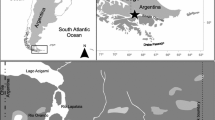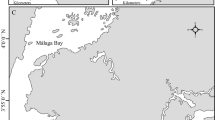Abstract
The food webs of a coastal lagoon ecosystem in the southeastern Gulf of California were investigated through the use of stomach contents analyses and carbon (δ13C) and nitrogen (δ15N) stable isotopes of fish and macroinvertebrates. Food sources and species representative of primary producers and primary-to-tertiary consumers were examined. Macroinvertebrates (47.5%) and fish (45%) assemblages represented over 90% of the total biomass. The most representative groups were fish (45%), crustaceans (24%), mollusks (16%), and echinoderms (8.5%). Based on the results from stomach content analysis, stable isotope analysis, and mixing models using Bayesian statistics, the estuarine food web was reconstructed from food chain bases to tertiary consumers, including the most representative species in the ecosystem. Four food webs were identified according to the primary producers, and five trophic levels were identified. However, in the higher trophic levels, these food webs are indistinguishable due to the high degree of omnivory and the complexity of the system which allows the predation in different environments.






Similar content being viewed by others
References
Albertini-Berhaut J (1974) Biologie des stades juveniles de teleosteens Mugilidae Mugil auratus Risso 1810, Mugil capito Cuvier 1829 et Mugil saliens Risso 1810. Aquaculture 4:13–27
Amezcua F, Amezcua-Linares F (2014) Seasonal changes of fish assemblages in a subtropical lagoon in the SE Gulf of California. Sci World J 2014:16–19
Amezcua F, Madrid-Vera J, Aguirre-Villaseñor H (2006) Effect of the artisanal shrimp fishery on the ichthyofauna in the coastal lagoon of Santa María la Reforma, southeastern Gulf of California. Ciencias Mar [Cienc Mar] 32:97–109
Amezcua F, Muro-Torres V, Soto-Jiménez MF (2015) Stable isotope analysis versus TROPH: a comparison of methods for estimating fish trophic positions in a subtropical estuarine system. Aquat Ecol 49:235–250. https://doi.org/10.1007/s10452-015-9517-4
Anderson MJ, Gorley RN, Clarke KR (2008) PRIMER+ for PERMANOVA: guide to software and statistical methods. 214. Primer-e, Plymouth
Baker R, Buckland A, Sheaves M (2014) Fish gut content analysis: robust measures of diet composition. Fish Fish 15:170–177
Bodin N, Le Loc’h F, Hily C (2007) Effect of lipid removal on carbon and nitrogen stable isotope ratios in crustacean tissues. J Exp Mar Biol Ecol 341:168–175
Choy EJ, An S, Kang CK (2008) Pathways of organic matter through food webs of diverse habitats in the regulated Nakdong River estuary (Korea). Estuar Coast Shelf Sci 78:215–226. https://doi.org/10.1016/j.ecss.2007.11.024
Choy EJ, Richard P, Kim KR, Kang CK (2009) Quantifying the trophic base for benthic secondary production in the Nakdong River estuary of Korea using stable C and N isotopes. J Exp Mar Biol Ecol 382:18–26. https://doi.org/10.1016/j.jembe.2009.10.002
Christensen V, Pauly D (1992) ECOPATH II—a software for balancing steady-state ecosystem models and calculating network characteristics. Ecol Model 61:169–185
Costanza R, Arge R, De Groot R et al (1997) The value of the world’ s ecosystem services and natural capital by. Nature 387:253–260. https://doi.org/10.1016/j.ijrobp.2010.07.1349
Coulter GW (1991) Lake Tanganyika and its life, G.W. Coulter (Ed.) with contributions from J.-J. Tiercelin, A. Mondegver, R.E. Hecky and R.H. Spigel, British Museum (Natural History) Publications — Oxford University Press, 1991. 354 pp. Price: £60.00. Aquat Conserv Mar Freshw Ecosyst 1:190–191. https://doi.org/10.1002/aqc.3270010210
Deegan LA, Garritt RH (1997) Evidence for spatial variability in estuarine food webs. Mar Ecol Prog Ser 147:31–47
DeNiro MJ, Epstein S (1977) Mechanism of carbon isotope fractionation associated with lipid synthesis. Science 197(80):261–263
Doi H, Matsumasa M, Toya T et al (2005) Spatial shifts in food sources for macrozoobenthos in an estuarine ecosystem: carbon and nitrogen stable isotope analyses. Estuar Coast Shelf Sci 64:316–322
Farquhar GD, Ehleringer JR, Hubick KT (1989) Carbon isotope discrimination and photosynthesis. Annu Rev Plant Physiol Plant Mol Biol 40:503–537. https://doi.org/10.1146/annurev.pp.40.060189.002443
Flores-Verdugo F, González-Farias F, Zaragoza-Araujo U (1993) Ecological parameters of the mangroves of semi-arid regions of Mexico: important for ecosystem management. In: Lieth H, Al Masoom AA (eds) Towards the rational use of high salinity tolerant plants. Springer, pp 123–132
Fontugne MR, Jouanneau J-M (1987) Modulation of the particulate organic carbon flux to the ocean by a macrotidal estuary: evidence from measurements of carbon isotopes in organic matter from the Gironde system. Estuar Coast Shelf Sci 24:377–387
Hill BJ, Wassenberg TJ (1993) Why are some prawns found in seagrass? An experimental study of brown (Penaeus esculentus) and grooved (P. semisulcatus) tiger prawns. Mar Freshw Res 44:221–227
Kaufman MR, Gradinger RR, Bluhm BA, O’Brien DM (2008) Using stable isotopes to assess carbon and nitrogen turnover in the Arctic sympagic amphipod Onisimus litoralis. Oecologia 158:11–22
Kline TC, Pauly D (1998) Cross-validation of trophic level estimates from a mass-balance model of Prince William Sound using 15 N/14 N data. In: Alaska Sea Grant College. Citeseer
Kwak TJ, Zedler JB (1997) Food web analysis of southern California coastal wetlands using multiple stable isotopes. Oecologia 110:262–277
Langton RW, Watling L (1990) The fish-benthos connection: a definition of prey groups in the Gulf of Maine. In: Trophic relationships in the marine environment: proceedings 24th European marine biology symposium, pp 424–438
Ley JA, Montague CL, Mclvor CC (1994) Food habits of mangrove fishes: a comparison along estuarine gradients in northeastern Florida Bay. Bull Mar Sci 54:881–899
Little C (2000) The biology of soft shores and estuaries. Oxford University Press, Oxford
Livingston RJ (1982) Trophic organization of fishes in a coastal seagrass system. Mar Ecol Prog Ser 7:1–12
Marczak LB, Thompson RM, Richardson JS (2007) Meta-analysis: trophic level, habitat, and productivity shape the food web effects of resource subsidies. Ecology 88:140–148
Minagawa M, Wada E (1984) Stepwise enrichment of 15 N along food chains: further evidence and the relation between δ15N and animal age. Geochim Cosmochim Acta 48:1135–1140
Moncreiff CA, Sullivan MJ (2001) Trophic importance of epiphytic algae in subtropical seagrass beds: evidence from multiple stable isotope analyses. Mar Ecol Prog Ser 215:93–106. https://doi.org/10.3354/meps215093
Newell RIE, Marshall N, Sasekumar A, Chong VC (1995) Relative importance of benthic microalgae, phytoplankton, and mangroves as sources of nutrition for penaeid prawns and other coastal invertebrates from Malaysia. Mar Biol 123:595–606
O’Reilly CM, Hecky RE, Cohen ASC, Plisnier PD (2002) Interpreting stable isotopes in food webs: recognizing the role of time averaging at different trophic levels. Limnol Oceanogr 47:306–309
Páez Osuna F, Ramírez Reséndiz G, Ruiz Fernández AC, Soto Jiménez MF (2007) La contaminación por nitrógeno y fósfoto en Sinaloa: Flujos, fuentes, efectos y opciones de manejo. Universidad Nacional Autónoma de México, Mazatlán
Page HM (1997) Importance of vascular plant and algal production to macro-invertebrate consumers in a southern California salt marsh. Estuar Coast Shelf Sci 45:823–834
Pasquaud S, Elie P, Jeantet C et al (2008) A preliminary investigation of the fish food web in the Gironde estuary, France, using dietary and stable isotope analyses. Estuar Coast Shelf Sci 78:267–279. https://doi.org/10.1016/j.ecss.2007.12.014
Pauly D (2007) The sea around us project: documenting and communicating global fisheries impacts on marine ecosystems. AMBIO J Hum Environ 36:290–295
Pauly D, Froese R, Rius M (2000) Trophic pyramids. In: Froese R, Pauly D (eds) FishBase. pp 203–204
Pikitch E, Santora C, Babcock EA et al (2004) Ecosystem-based fishery management. Science 305:346–347
Polis GA, Anderson WB, Holt RD (1997) Toward an integration of landscape and food web ecology: the dynamics of spatially subsidized food webs. Annu Rev Ecol Syst 28:289–316
Polunin NVC, Pinnegar JK (2000) Trophic-level dynamics inferred from stable isotopes of carbon and nitrogen. Fish Down Mediterr Food Webs 12:69–72
Post DM (2002) Using stable isotopes to estimate trophic position: models, methods, and assumptions. Ecology 83:703–718
Robertson DR, Allen GR (2006) Shorefishes of the tropical eastern Pacific: an information system: an information system. Panama Smithson Trop Res Insitute, Balboa
Roy PS, Williams RJ, Jones AR et al (2001) Structure and function of south-east Australian estuaries. Estuar Coast Shelf Sci 53:351–384. https://doi.org/10.1006/ecss.2001.0796
Shephard SA, McComb AJ, Bulthuis DA et al (1989) Decline of seagrasses. Elsevier Science Pub.
Siqueiros-Beltrones D, Argumedo-Hernandez U (2006) Identificación de Diatomeas en Contenidos Intestinales de Camarones para ubicar su sitio de captura, un caso jurídico. Conversus 53:22–24
Tandel SS, Athalye RP, Gokhale KS (1986) On the seasonal changes in food habit of Mugil cephalus of the Thana Creek. Indian J Fish 33:270–276
Thomas SM, Crowther TW (2015) Predicting rates of isotopic turnover across the animal kingdom: a synthesis of existing data. J Anim Ecol 84:861–870
Tieszen LL, Boutton TW, Tesdahl KG, Slade NA (1983) Fractionation and turnover of stable carbon isotopes in animal tissues: implications for δ13C analysis of diet. Oecologia 57:32–37
Toscano AL, Ochoa DR (2003) Evaluacion/sistematizacion de la experienca del proceso para establecer una Estrategia de Manejo para la Conservacion y desarrollo de bahia Santa Maria. –Un documento sintetiza de los resultados del estudio. Narragansett
Vanderklift MA, Ponsard S (2003) Sources of variation in consumer-diet δ15N enrichment: a meta-analysis. Oecologia 136:169–182
Wainright SC, Weinstein MP, Able KW, Currin CA (2000) Relative importance of benthic microalgae, phytoplankton and the detritus of smooth cordgrass Spartina alterniflora and the common reed Phragmites australis to brackish-marsh food webs. Mar Ecol Prog Ser 200:77–91
Wissel B, Fry B (2005) Tracing Mississippi River influences in estuarine food webs of coastal Louisiana. Oecologia 144:659–672
Worm B, Hilborn R, Baum JK et al (2009) Rebuilding global fisheries. Science 325:578–585. Kapiti Mar Reserv (New Zealand) 89
Yokoyama H, Tamaki A, Koyama K et al (2005) Isotopic evidence for phytoplankton as a major food source for macrobenthos on an intertidal sandflat in Ariake Sound, Japan. Mar Ecol Prog Ser 304:101–116. https://doi.org/10.3354/meps304101
Zar JH (1999) Biological statistics. Prentice Hall, Upper Saddle River
Acknowledgements
A.N. Rojas prepared the samples for isotopic analysis. Financial support was provided by the projects PAPIIT-UNAM IN217408 and IN215206. V. M. Muro-Torres and J. Quintero thank CONACYT for the Ph.D. grant.
Author information
Authors and Affiliations
Corresponding author
Additional information
Handling Editor: Télesphore Sime-Ngando.
Publisher's Note
Springer Nature remains neutral with regard to jurisdictional claims in published maps and institutional affiliations.
Rights and permissions
About this article
Cite this article
Muro-Torres, V.M., Soto-Jiménez, M.F., Green, L. et al. Food web structure of a subtropical coastal lagoon. Aquat Ecol 53, 407–430 (2019). https://doi.org/10.1007/s10452-019-09698-0
Received:
Accepted:
Published:
Issue Date:
DOI: https://doi.org/10.1007/s10452-019-09698-0




